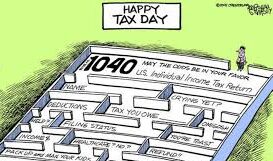
April is tax season, as taxpayers are painfully aware. Every year a large proportion of individual income taxes are paid in April. But, depending upon the economy and stock market, April tax payments vary significantly year to year and their composition even more so.
In April 2019, individuals across the land paid $397 billion in income taxes. Of that, $263 billion were “other” taxes, namely taxes on non-wage income. Three year later, in April 2022, individuals paid $642 billion, of which a whopping $515 billion were other taxes, mostly from stock market gains.
The hundred-billion dollar question in Washington these days is how much will arrive this month.
Following the national pattern, the one-billion dollar question in Hartford is how much will arrive this month – a question that will be answered in large part tomorrow. By state law, the Secretary of the Office of Policy and Management is required to furnish the State Comptroller by the 20th of each month a statement of year-to-date revenues and a statement of estimated revenue by source through the end of the fiscal year.
The big question is how much non-wage related income taxes the state has already collected and how much it expects to collect. In Connecticut, non-wage income taxes fall in two categories, so-called Estimates & Finals (E&F) and the pass-through entity tax (PET).
In his letter last March 20th, the Secretary of OPM confirmed again (for the eighth time) the estimate of OPM and the Office of Fiscal Analysis that $5.5 billion of gross E&F and PET taxes will be collected this fiscal year. In a study conducted in March, The Townsend Group, which I head, forecast just $4.4 billion of net taxes for the fiscal year ending June 30th.
The study culminated a months-long public debate that I have waged with OPM and OFA over this issue, as I outlined in a column earlier this month. That there is debate nine and a half months into the fiscal year is a function of the fact that only a small proportion of non-wage income taxes are paid much before April. Usually only about one-quarter of such taxes are paid in the first half of the fiscal year, and one-third is paid in April.
Since final returns for the PET tax were due on March 15th, the OPM letter tomorrow will include most of the actual PET receipts for the fiscal year. In their Consensus Revenue Forecast in January, OPM and OFA confirmed their long-standing estimate of $1.957 billion of PET revenue.
Inasmuch as final income tax returns were due only yesterday, the “F” of E&F tax payments will remain an open question. So, the OPM Secretary’s estimate will be more important than actual E&F receipts so far this fiscal year.
A key factor in the outcome of the debate over E&F and PET tax receipts for the fiscal year will be refunds. In the Consensus Revenue Forecast, refunds for all tax categories are combined. This obscures the amount of net receipts for E&F and PET taxes, except that refunds of E&F and PET taxes comprise almost all of the combined refund number.
For example, according to the Monthly Comparative Statement of Tax Revenue from the Department of Revenue, total refunds through February were $997 million, of which E&F and PET refunds accounted for $851 million, or 85%. The Consensus Revenue Forecast projects $1.827 billion of refunds this fiscal year.
Refunds are critically important this year as demonstrated by IRS experience. In February and March of this year, refunds of other income taxes exceeded payments. For the two months, net other receipts were a negative $70 billion.
The outcome of the debate is critically important to the State of Connecticut. $1.1 billion is a huge amount of money in the Nutmeg State, despite that it is pocket change for Uncle Sam. For the sake of the state, let’s hope that OPM and OFA are right… or more accurate.
Without diminishing the importance of the debate, I would offer to the Secretary of OPM and the Director of OFA, that I will buy them lunch if they are more accurate about E&F and PET receipts for the fiscal year, i.e. if combined receipts exceed $4.95 billion, adjusted for refunds.
![]()
Red Jahncke is a nationally recognized columnist, who writes about politics and policy. His columns appear in numerous national publications, such as The Wall Street Journal, Bloomberg, USA Today, The Hill, Issues & Insights and National Review as well as many Connecticut newspapers.





